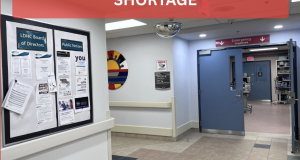We’ve been lucky so far, there hasn’t been any significant snowfall or road closures due to poor weather. However, that may change, and change within hours. A road closure due to a serious motor vehicle collision can also strand motorists on the side of the highway for a number of hours.
Before you travel make sure you have checked weather forecasts, have a full tank of gas and let someone know you are heading out and when you expect to arrive – file a flight plan. Most importantly – if you feel the weather is too poor to travel – DON’T. The variety and severity of weather patterns generated from Lake Superior often pose problems for highway maintenance during winter storms. In most cases, travel can be postponed to allow for weather to clear and roads to be better.
If you have to travel always have safety and emergency equipment in your car. A basic vehicle travel kit should contain the following:
- Food that won’t spoil, such as energy bars, dried fruit, fruit leather
- Water—plastic bottles that won’t break if the water freezes (replace them every six months)
- Blanket(s)
- Extra clothing and shoes or boots
- First aid kit with seatbelt cutter
- Candle in a deep can and matches
- Wind‑up flashlight
- Whistle—in case you need to attract attention
- Antifreeze and windshield washer fluid
- Tow rope
- Jumper cables
- Fire extinguisher
- Warning light or road flares
- Roadmaps
- Copy of your emergency plan
- Toilet Paper!
For winter time travel, consider:
- Small shovel, scraper and snowbrush
- Sand, salt or cat litter (non-clumping)
Other thoughts:
- battery pack for electronic devices.
- cellphone booster to extend cell phone range in poor areas of connectivity.
- a paperback book or a couple of kids books, deck of cards – small things to while away the time if stranded
If you are stuck in the snow:
- Try to stay calm and don’t go out in the cold. Stay in your car: you will avoid getting lost and your car is a safe shelter.
- Don’t tire yourself out. Shovelling in the intense cold can be deadly.
- Let in fresh air by opening a window on the side sheltered from the wind.
- Keep the engine off as much as possible. Be aware of carbon monoxide poisoning and make sure the exhaust pipe is not obstructed by snow.
- If possible, use a candle placed inside a deep can instead of the car heater to warm up.
- Turn on warning lights or set up road flares to make your car visible.
- Turn on the ceiling light; leaving your headlights or hazard lights on for too long will drain the battery. Or keep a small led lantern for light.
- Move your hands, feet and arms to maintain circulation. Stay awake.
- Keep an eye out for other cars and emergency responders.
- Try to keep clothing dry since wet clothing can lead to a dangerous loss of body heat.
- Tuesday Morning News – December 30 - December 30, 2025
- Winter Road Conditions & Weather – Tuesday, December 30th - December 30, 2025
- Highway Status (6:51) - December 30, 2025
 Wawa-news.com You can't hear the 'big picture'!
Wawa-news.com You can't hear the 'big picture'!


